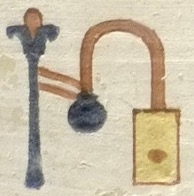



This page displays details of the selected Monument. Click on the Monument number to list all individual signs ("occurrences") recorded from that object or structure.
Monument : Horemheb KV.57
Period : Dynasty XVIII
Reign(s) : Horemheb
High Date : 1323
Low Date : 1295
Monument type : Royal Tomb
Localisation or provenance : Valley of the Kings
References : PM I, 2, 567-569; Hornung (1971).
The tomb of Horemheb has been greatly damaged, both by human intervention and by flooding, most recently in 1994. However, some painted reliefs remain largely intact, especially in well chambers E and J, whence have been taken the images assigned to the occurrences. The photographs are all taken from Hornung (1971, pls.1a-22b). One striking feature of the reliefs is the blue-grey background, probably representing the darkness of the underworld, the abode of the many gods and goddesses figured in the scenes. This background colour contrasts well with the bright colours used in the inscriptions. It also allows the scribe-painter to use white in order to show transparency, empty space and movement. This is particularly clear in the occurrences from the tomb of the following signs : D21, D54, O1, O42, S34, S38, U6, etc. Even the sign V28 , a length of twisted flax, has the top loop and the space between the two loose ends painted white. M18 is an interesting composite hieroglyph that has the space between the stem of the reed and the forward pointing foot painted white, giving the whole sign a sense of movement. The colours used in the inscriptions are rich, deep shades of black, white, red, yellow, green and blue. Yellow sometimes appears to be almost red, but comparisons with adjacent signs normally help to distinguish between the colours. A good example is of the two signs D1 and D2 which can be found one above the other (Hornung 1971, plate 7) and which show the face of D2 as a deep orange shade instead of the usual yellow, whereas the profile D1 is shown as deep red. Other occurrences of the same arrangement of these two signs (Hornung 1971, plate 17) show the frontal view to be a clear yellow. The two variants of D2 have therefore been recorded in the corpus for this monument.